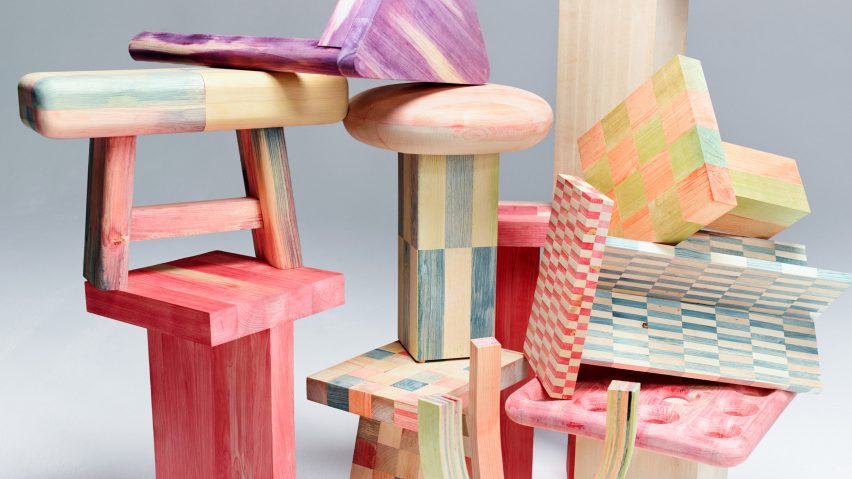Norway-based Studio Sløyd has developed a process for dyeing entire blocks of wood and used it to produce 24 playful multi-coloured stools.
Studio Sløyd founders Herman Ødegaard and Mikkel Jøraandstad showcased their series of "through-coloured" wood stools in the exhibition Roggbif at Oslo boutique Sorgenfri.
Their process is unusual in that it applies colour through an entire piece of wood rather than just on the outer surfaces, opening up new manufacturing possibilities.
The technique could also extend the longevity of products because it is less noticeable if the wood becomes chipped or dented, while surface marks can be sanded away without the need to refinish the pieces.
"We have not seen coloured wood like this before," Ødegaard told Dezeen. "We thought it was worth showing to people."
"It's unique that you have the possibility to sand and work with the material after colouring it, rather than the other way round," he added. "The colour will not disappear no matter how much you work it."
The 24 stools created for the exhibition showcase the possibilities for applying this technique to furniture across a range of different joinery techniques.
Many of the Roggbif stools combine woods dyed with different pigments, resulting in various colour contrasts and surface patterns.
Ødegaard first started developing the technique while studying for his masters at the Oslo National Academy of the Arts.
After a long process of testing, he and Jøraandstad have refined a process that sees birch wood placed inside a vacuum chamber alongside specially developed colour pigments and water.
The pair are keeping the precise details of the method to themselves as they hope to secure a patent.
"When you take the wood out of the chamber, it's dyed all the way through," said Ødegaard. "We think it can be a great medium to work with."
Studio Sløyd presented the first Roggbif pieces – a round-seated stool and a tri-colour stepladder – as part of the Norwegian Presence exhibition in Milan in 2023.
The expanded collection saw the duo experiment further. Highlights include Vimpel, which uses a marquetry technique to create a tesselating triangle pattern and the 11 2000 stool, which is decorated with debossed illustrations.
Ødegaard's favourites include Knapper, named after the Norwegian word for buttons, which features bulging spots, and Blekksprut, which features curved, stripy legs made possible by lamination.
"It would be quite hard to do this if only the surface of the material was coloured," he said.
Roggbif is not the first self-initiated project that Studio Sløyd has exhibited. In 2020, when the pair were working as a trio with former partner Tim Knutsen, they unveiled a series of works in pine wood.
Ødegaard and Jøraandstad plan to continue making time for experimentation in their practice, alongside commercial projects like recent collaborations with Norwegian furniture brands Northern and LK Hjelle.
All of the stools presented in the Roggbif exhibition were sold within two hours of the exhibition opening. The show also included material samples and prototypes, so visitors could learn more about the development process.
Previously, the studio created a collection of chunky chairs to challenge perceptions of "outdated" pine furniture.

